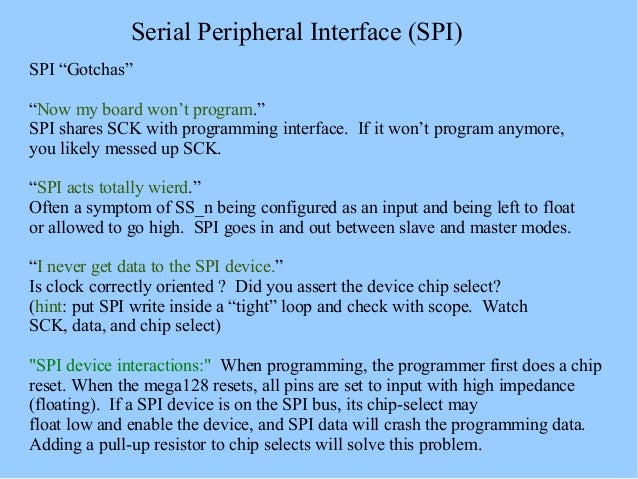How To Program Spi Interface
ESP8266_SPI_Driver - Driver code to interface with ESP8266 built-in hardware SPI functions. The SPI bus interface is pretty simple for this one, and is shown in the diagram shown below. SPI Bus – Single Master Multiple Slaves (Click to Enlarge) All the Slaves share the same MOSI, MISO and SCK signals.
SPI interface Tutorial. The SPI Interface (Serial Peripheral Interface) bus is a high speed, 3-wire, serial communications protocol (4 if you include SSn - see below). Its primiary purpose is to reduce on-PCB wire routing by replacing the traditional parallel bus with a serial interface. (You can just about manage an 8 bit bus routing it through a several layer PCB but when you get to 16, 32 bits and more it gets far more difficult). The connections are: • MOSI (Master Out Slave In) [SDO].

• MISO (Master In Slave Out) [SDI]. • SCK (Slave Clock) [SCK]. • SS_n (Slave Select). [] - denotes PIC nomenclature Note: The last signal SS or slave select is separate from the protocol and is usually implemented as an enabling control pin from the microcontroller. It is included here for completeness. The SPI PIC interface allows connection of peripherals using a high speed serial interface.
SPI Flash Memory and SPI SRAM can easily be added to any system. Other types of device include: • ADC. • Accellerometers. • Temperature & Humidity sensors. •.and many more. Its only other real competition is the I2C bus which is why you often see these interfaces both available on processors and microcontrollers. The SPI interface was designed in the 1970s by Motorola, who used it in their 68000 processor, and it was quickly adopted by many other manufacturers as a defacto standard.
It is intended for transmission of data from a master device to one or more slave devices over short distances and at high speeds (MHz). How it Works It works by transferring data one bit at a time between two devices with the master device sending the clock signal (SCK). The clock controls the timing of the data transfer. Joy Division Unknown Pleasures 1979 Rar more. Data (MOSI [SDO] )is sent out of a shift register in the Master SPI device along with a clock signal (SCK) while at the same time another shift register receives data from the slave (MISO, [SDI]). The Master is always in control and initiates data transfer using the clock signal. Slave devices are selected using a separate slave select signal that is software controlled i.e.
Those signals are separate from the SPI hardware module. Note: SPI defines a single master system.
The alternative protocol, IIC, allows multiple bus master operation. SPI interface Clock Definition The SPI clock is not defined at all - meaning that different slave devices can assume different clock operation; One slave may require an idle clock that is high, while another may require an idle state of low.
Others will react to the rising edge while others react to the falling edge! The SPI interface protocl copes with this by letting you program these details to the SPI hardware module. Blaupunkt Valencia Mp 36 Manual. The following image shows the PIC interface for SPI (all SPI hardware modules in other microcontrollers will allow the same operation just using different registers). SPI Interface PIC signals (extract from PIC datasheet DS39582B). With this scheme you control each slave device using its chip select line (usually active low- red arrows show control lines). When disabled the Data output from the slave goes into a high impedance state so it does not interfere with the currently selected slave and the slave's data input is ignored (check datasheet). The advantage of this scheme is that you can consider (control) each device separately when you compare it with the daisy chain method - allowing connection of SPI devices that require different clock schemes.